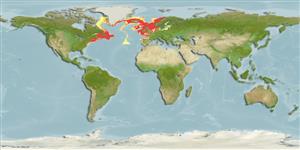Environment: milieu / climate zone / depth range / distribution range
Ökologie
seewasser demersal; ozeanodrom (Ref. 51243); tiefenbereich 18 - 1570 m (Ref. 5951), usually 45 - 366 m (Ref. 6263). Temperate; 2°C - 6°C (Ref. 6263); 70°N - 36°N, 79°W - 26°E
Western Atlantic: Gulf of St. Lawrence and Grand Banks in Canada to North Carolina in USA; Eastern Atlantic: Northern Spain to northern Norway (Ref. 7251).
Length at first maturity / Size / Gewicht / Alter
Maturity: Lm 30.4 range ? - ? cm
Max length : 60.0 cm SL Männchen/unbestimmt; (Ref. 4705); max. veröff. Gewicht: 2.5 kg (Ref. 35388); max. veröff. Alter: 25 Jahre (Ref. 6263)
Rückenflossenstacheln (insgesamt): 0; Rückenflossenweichstrahlen (insgesamt): 95-120; Afterflossenweichstrahlen: 85 - 102. Pectoral fin of eyed side shorter than head. Distal part of pectoral fin blackish (Ref. 232). Large mucus pores on the blind side of the head. Uniform coloration, rough scales. Body elongated with complete straight lateral line (Ref. 35388).
Inhabits soft mud bottoms in fairly deep water (Ref. 9988). Benthic (Ref. 58426). Feeds on crustaceans, polychaetes, brittle stars (Ref. 9988) and fishes (Ref. 58426). Marketed fresh or frozen; eaten steamed, fried, microwaved and baked (Ref. 9988).
Eggs and larvae are pelagic.
Vinnikov, K.A., R.C. Thomson and T.A. Munroe, 2018. Revised classification of the righteye flounders (Teleostei: Pleuronectidae) based on multilocus phylogeny with complete taxon sampling. Molecular phylogenetics and evolution, 125:147-162. (Ref. 122998)
IUCN Rote Liste Status (Ref. 130435)
Bedrohung für Menschen
Harmless
Nutzung durch Menschen
Fischereien: kommerziell
Tools
Zusatzinformationen
Download XML
Internet Quellen
Estimates based on models
Preferred temperature (Ref.
123201): 0.6 - 11.4, mean 7 °C (based on 1302 cells).
Phylogenetic diversity index (Ref.
82804): PD
50 = 0.6250 [Uniqueness, from 0.5 = low to 2.0 = high].
Bayesian length-weight: a=0.00457 (0.00365 - 0.00573), b=3.08 (3.01 - 3.15), in cm total length, based on LWR estimates for this species (Ref.
93245).
Trophic level (Ref.
69278): 3.2 ±0.2 se; based on diet studies.
Generation time: 5.5 (4.8 - 9.9) years. Estimated as median ln(3)/K based on 11
growth studies.
Widerstandsfähigkeit (Ref.
120179): mittel, Verdopplung der Population dauert 1,4 - 4,4 Jahre. (K=0.15-0.2; tmax=25).
Prior r = 0.49, 95% CL = 0.32 - 0.73, Based on 1 stock assessment.
Fishing Vulnerability (Ref.
59153): High to very high vulnerability (68 of 100).
Climate Vulnerability (Ref.
125649): Low to moderate vulnerability (34 of 100).
Nutrients (Ref.
124155): Calcium = 25.1 [10.1, 45.7] mg/100g; Iron = 0.237 [0.120, 0.463] mg/100g; Protein = 16.7 [15.4, 18.1] %; Omega3 = 0.36 [0.18, 0.76] g/100g; Selenium = 26.6 [13.3, 56.7] μg/100g; VitaminA = 8.58 [1.93, 36.75] μg/100g; Zinc = 0.455 [0.302, 0.676] mg/100g (wet weight);
